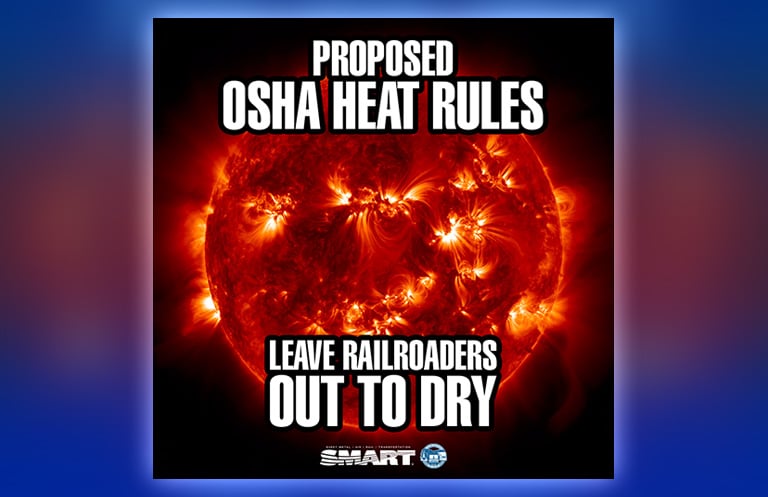
Washington, D.C. — The Occupational Safety and Health Administration (OSHA) has proposed a new rule aimed at preventing heat-related injuries and illnesses for workers across industries. Published in the Federal Register under Docket No. OSHA-2021-0009, the proposal is well-intentioned, but SMART-TD has expressed its concerns about how the rule might overlook the unique and often dangerous realities of working in the rail industry.
Support for Worker Safety, but Serious Concerns About Railroad-Specific Gaps
As the largest rail labor union, SMART-TD backs OSHA’s broader goal of preventing heat-related illness, especially for industries like construction, agriculture, and transit where workers are often exposed to extreme temperatures. We are glad to see OSHA protecting these workers, but when it comes to the railroads, our response to the proposed regulations is a bit more skeptical. Rail workers don’t just face heat: we face it in a way that is unique to this job, which isn’t fully acknowledged by OSHA’s proposal.
Unlike other industries where workers can take frequent breaks or retreat to a cool space, railroad employees often have no choice but to work in sweltering conditions for hours on end, sometimes without access to water, shade, or any kind of relief.
The Harsh Realities of Working on the Rails
For instance, take the conductors and other rail workers who spend long hours walking miles along tracks to inspect trains in remote locations. This work, which can take hours, requires us to be off the engine and away from the icebox and water. Any break we take isn’t guaranteed to include shade and is more likely to extend our exposure than offer any real relief.
Even when we are on the engine, railroaders aren’t always safe from the elements. When the air conditioning breaks down or when the locomotive isn’t equipped with it, rail workers are left to endure unbearable heat for the duration of their shifts. Twelve hours (or more if they forgot to order you a cab) in a locomotive without AC is not safe.
Locos aren’t exactly luxurious to begin with. They are small workspaces with metal interiors that are full of electronics. When there is no AC on hot days, it can feel like you are rolling down the rails in an oven.
In short, rail workers are often left to fend for themselves when it comes to protecting against heat illness in every aspect of their work.
Railroads Have Long Ignored Worker Safety While Punishing Whistleblowers
SMART-TD doesn’t mince words when it comes to the railroads’ track record on worker safety. While the heat injuries are real and ongoing, the response from rail companies has been disappointing at best. Often, railroads downplay heat-related illnesses, or worse, fail to take them seriously at all. Workers who have had the audacity to point out safety concerns aren’t met with support but rather retaliation. It’s a pattern: workers raise safety alarms, and the railroads go after them, often threatening jobs and careers just for speaking out.
This isn’t a new issue. In fact, whistleblowers within the railroad industry who report safety hazards, including heat-related risks, are frequently punished. Rather than addressing the root cause of the problem, railroads have been focused on silencing those who dare to bring attention to unsafe conditions. It’s a culture of retaliation that has been deeply ingrained in the industry, leaving workers feeling like they have nowhere to turn for help.
The Need for Rail-Specific Protections in OSHA’s Heat Rule
OSHA’s proposed rule is a step in the right direction, but it’s not enough for rail workers. The working conditions in the railroad industry require tailored measures that go beyond general heat exposure guidelines. Rail workers face challenges that are far more extreme than what’s encountered in other industries and without specific provisions for this sector, the rule risks missing the mark.
Using Technology to Improve Heat Monitoring—But Without the Risk of Retaliation
One area SMART-TD supports is the idea of using technology to monitor heat exposure. Our union has suggested the use of automatic thermometers in locomotive cabs to track and manage heat stress. This approach would allow for better monitoring without putting the burden on workers to speak up or self-report their heat exposure to avoid retaliation. Workers should not be forced to choose between their health and their job.
Moving Forward: Holding Railroads Accountable
SMART-TD is committed to working with OSHA to ensure the final rule takes into account the unique and hazardous conditions faced by rail workers. This union has long been fighting for better federal protections, and we aren’t backing down now. We’re pushing for regulations that will actually safeguard the well-being of railroad workers, rather than allowing them to be ignored or pushed aside as we have been in the past.
The railroads need to do more than just talk about worker safety. OSHA needs to take meaningful action and force change. SMART-TD is determined to make sure OSHA’s heat injury prevention rule holds railroads accountable.
The safety and well-being of rail workers cannot be an afterthought. It’s time for our industry to take responsibility and for OSHA to ensure rail workers get the protection we deserve. We can’t allow ourselves to continue to be the exception to every pro-worker policy.
Related News
- Chairman Pauli Announces Retirement, SMART-TD celebrates his career
- SMART statement on Supreme Court’s decision regarding Kilmar Armando Abrego Garcia’s return to the United States
- SMART-TD Stands With Brother Kilmar Abrego Garcia
- New Mexico Local 1687 sets new precedent with Red Apple Transit
- Tentative Agreement Reached With TransitAmerica Services (TASI)
- SMART issues Monday, April 7, statement on Kilmar Armando Abrego Garcia’s ongoing case
- Local 5 organizes enormous growth in North Carolina
- Make sure your voice is heard, update your contact information
- SMART statement on Kilmar Armando Abrego Garcia’s right to due process
- Union leaders, community supporters to rally Friday, April 4, in support of Kilmar Armando Abrego Garcia and family